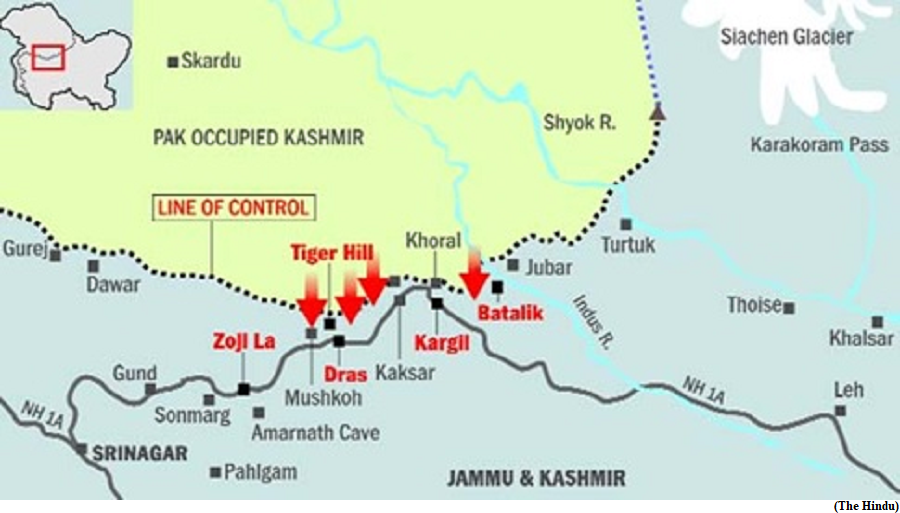Kaobal Gali Mushkoh Valley opens up for tourists (GS Paper 1, Geography)

Why in news?
- The high-altitude passes of the Gurez valley in north Kashmir, has been opened up for tourists.
Details:
- It was once prone to frequent shelling from Pakistan. Now, it is all set to connect with the Mushkoh valley, in Kargil’s Drass Sector, Ladakh, the site of the war in 1999.
- Kaobal Gali, the highest pass at a height of 4,166.9 metres in Gurez, connects the two valleys.
Characteristic features:
- The Gurez valley is one of few habitations in Kashmir where villages with only log houses exist, with no intervention of urban concrete materials.
- It is also home to ibex, musk deer and marmots.
- The meadows of Mushkoh offer boisterous wild tulip flowers and views of breath-taking glaciers.
- The valley is also home to the endangered Himalayan yew.
Potential:
- As the ceasefire agreement between India and Pakistan continues to hold for the 43rd month, people are hopeful that with prevailing peace will come commerce from tourism.
- The Gurez valley, with about 38,000 residents, is already setting a record by hosting 50,000 tourists in 2023. The administration sees huge tourist potential in opening the Gurez-Drass road to tourists.
Tamil Nadu, Kerala to join hands to count endangered Nilgiri tahr
(GS Paper 3, Environment)
Why in news?
- After launching Project Nilgiri Tahr in 2022 for the conservation of the State animal, Tamil Nadu is now working on a standardised protocol to count the endangered population of southern India’s only mountain ungulate.
- The Tamil Nadu Forest Department will also propose to its Kerala counterpart to conduct a synchronised census, as the animal is only found in select habitats in the two States.

Details:
- For the first time, drones may be used in the census, as the Nilgiri tahr prefers montane grasslands, with steep and rocky terrains at an altitude between 300 metres and 2,600 metres above sea level.
- There are believed to be a little over 3,100 of the animals living in highly fragmented habitats in the Western Ghats in Tamil Nadu and Kerala, ranging between the Nilgiris in the north and the Kanniyakumari hills in the south.
Synchronised survey:
- The Tamil Nadu Forest Department is proposing two censuses: one in November, after the southwest monsoon, and the other in March or April, after the calving season.
- If Kerala agrees to the proposal, the second census is likely to be a synchronised count.
- Experts felt that bounded count and double-observer survey methods could be priority models. Camera traps could also be used in difficult terrains.
Threats:
- Besides anthropogenic pressures, Nilgiri tahr habitats face threats from invasive plants such as wattles, pines, and eucalyptus in the grasslands.
- A component of the Project Nilgiri Tahrs aims to study the possible causes of the lumpy skin disease that has been observed in the animal, and suggest a remedy for it.
About Nilgiri Tahr:
- Nilgiri Tahr is also known as Nilgiri Ibex.
- It has been listed as “Endangered” by IUCN.
- It has been listed under Schedule 1 of the Wildlife (Protection) Act, 1972 which provides absolute protection and offences under these are prescribed the highest penalties
- The Adult males of Nilgiri Tahr species develop a light grey area or “saddle” on their backs and are hence called “Saddlebacks”
- It is the state animal of Tamil Nadu.
- It is found in open montane grassland habitat of rain forests ecoregion.
- It is endemic to the Nilgiri Hills and the southern portion of the Western Ghats in Tamil Nad and Kerala
Neural circuitry of mouse mothers to pups’ calls deciphered
(GS Paper 3, Science and Technology)
Why in news?
- The neural circuitry underlying the responses of mouse mothers to calls from their pups has now been studied by researchers. This mechanism may be important for sustaining mouse maternal care.

Oxytocin neurons:
- The hormone oxytocin is known to be important for maternal physiology and behaviour; for example, it has roles in childbirth and in milk ejection during nursing.
- In humans, baby cries are a powerful signal of infant distress, and most nursing mothers respond to cries with oxytocin release, increased hypothalamic activity, comforting behaviours towards the infant and occasional milk ejection.
- The neural circuitry that routes auditory information about infant distress calls to oxytocin neurons is unclear.
Highlights of the research:
- Researchers recorded the neural activity of oxytocin neurons in maternal mice whilst their pups were calling.
- They found that these neurons responded via input from a region of the brain called the posterior intralaminar thalamus.
- This circuit was found to control oxytocin release and pup retrieval, providing a mechanism for the integration of sensory cues from the offspring into maternal hormone networks to promote efficient parenting.
Way Forward:
- The findings help to understand how sensory cues from offspring are processed by neural circuits to activate the release of neuromodulators such as oxytocin, which alter maternal behaviour.




